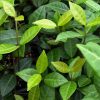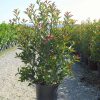Need Some Shade? Consider Shade Trees
In the Hot Texas Summers trees become truly valuable commodities that can help keep your house cool, yard enjoyable and aesthetically pleasing. Shade trees are typically one of our first thoughts when designing or renewing our landscapes. The Shade Trees you select will play an intricate role in the decision making process for all other plant material selected for your landscape. In North Texas we have many choices when selecting a Shade Tree. It’s important to select the right tree for the right location.
Some important factors to think about when choosing a shade tress are where, when, and how much shade you will require from your shade trees. You will also need to decide if the trees you choose will be evergreen or deciduous or some of both. Evergreen trees will provide shade year round, helping to cool your home during extreme heat as well as helping to block the winter winds. Whereas a deciduous tree planted on the same side will only provide shade during the growing season and will do nothing to block the winter winds. Will you be using this tree as protection from winter winds, summer heat or simply for aesthetic purposes?
Popular Shade Tree Selections for North Texas
Live Oak (Quercus virginiana)
Evergreen Shade Tree with shiny dark green and pale gray leaves. Growing upwards of 60 feet tall and spreading 75 to 100 feet wide. Best planted in full sun. Tolerates a wide range of soil types. This Tree has a life expectancy of over 100 years.
Shumard Red Oak (Quercus shumardii)
Deciduous Shade Tree with dark green leaves. Brilliant display of fall colors in deep reds and burgundy. Growing over 100’ tall. Best planted in full sun. Tolerates a wide range of soil types. This Tree has a life expectancy of 100 years or more.
Bald Cypress (Taxodium distichum)
Deciduous Shade Tree with light to medium green fern like leaves. Copper to bronze fall color. With heights of 40 to 60 feet tall. Does well in drought or wet conditions. This Tree has a life expectancy of 60 years plus.
Chinese Pistach (Pistacia chinensis)
Deciduous Shade Tree with deep dark green foliage. Excellent fall color in shades of orange, red-orange and crimson. Mature height of 40 to 50 feet tall. Does well in drought and excessive heat one established. This Tree has a life expectancy of 50 years or more.
The Do’s & Dont’s of Shade Trees
Avoid the urge to plant really fast growing trees. Fast growing trees will certainly give us the desired effect quickly, but in return there are many negatives as well. Fast growing trees can be susceptible to heat stress, insects and disease problems such as borers, leaf beetles, lace bugs, webworms and cotton root rot. Fast growing trees also tend to have short life spans witch means planting multiple trees over time to maintain the desired shade and landscape effects. Here is a list of some fast growing but less desirable trees.
- Weeping willows
- Cottonwood
- Arizona Ash
- Sycamores
- Fruitless Mulberry
- Mimosa
Choose slower to medium growing trees that will over time become a permanent part of your landscape as well as your home. Trees like Live Oaks and Red Oaks can increase the value of your property by as much as 20 percent. Some excellent choices for Shade Trees are listed here.
Water all newly planted Shade Trees immediately after planting. In order to become established, most newly planted Trees require regular watering for at least six months to one year. Established Shade Trees should be watered every 7 to 10 days during prolonged periods of drought or dry spells. During cooler seasons, less watering is needed because evaporation from the leaves occurs more slowly.
Deep infrequent watering is the key to establishing a healthy deep-rooted tree that will require less water over time. Trees that are watered deeply will establish deep roots lessening the chance of foundation damage or structural damage to sidewalks and driveways. Concentrate the water to the area around the root ball rather than on the leaves, this allows for quicker absorption through the root system instead of the foliage.
Water in the early morning hours, this gives the plant and the soil around the roots time to dry through out the day. This also allows the plant to absorb the water more easily with less water loss due to evaporation. Different trees have different water requirements; some are drought tolerant meaning they will require less water once established. Others will tolerate and or even require heavier amounts of water throughout the growing season.
Feeding your Shade Trees in late February to early March with Fertilome Tree And Shrub Food will help to ensure a healthy viable plant for years. See all trees at Premier Nursery.



